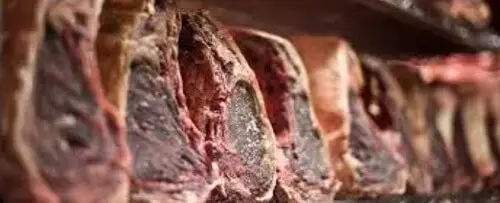You’ve probably seen dry-aged beef on the menu at your local butchers or favourite steak house, but what exactly is it and is the higher cost justified? In this post we will explain how we dry-age, why we dry-age and what’s in it for you!
Only the best quality beef can be dry-aged, as it’s important the meat has an evenly distributed fat content.
So from the get-go, we’re talking an increased price. Add in the fact that as the beef ages, it shrinks, while the surfaces exposed to air develop a kind of crust, which is trimmed off and discarded when the meat is butchered into smaller cuts. Factor in the time invested – anywhere from 20 to 80 days – it all adds up. So when you’re talking about dry-aged beef, it isn’t a budget option.
But when you cut into a well-cooked, well-rested, dry-aged steak … it’s worth every last cent. Dry-ageing is a precise and exacting process best done by professionals, so go to a good butcher. Once it’s in your hot little hands, treat it simply and whatever you do, don’t overcook it.

Dry Ageing Process
Butchers have been dry-aging meat for millennia and it’s a process we, along with other meat specialists, continue to practise today. So how does dry-aging happen? Once our Gingin Grass Fed beef reaches maturity, it’s taken to the abattoir for processing and the meat is left to hang in a cool room for a few weeks. It’s the next step where dry aging comes into play. We then hang the meat a bit longer, exposing it to a set temperature in a controlled environment.
The combination of temperature, humidity and air quality allows moisture to evaporate from the meat and oxidate fat and other fat-like molecules, while the meat’s natural enzymes break down the connective tissue in the muscle. The result: a high concentration of natural meaty flavour, combined with a tenderness unparalleled to standard beef options. Think of dry-aged beef as the carnivorous equivalent of a fine wine or mature cheese – the yield isn’t as high, it costs a bit more but the taste and experience are incomparable to lower quality counterparts!
The Dry-Aged Difference
Did you know most of the beef you buy is only aged for a few days before it hits the butchers’ shelves?
The main difference between dry aged and wet aged meat is how much moisture the meat contains. The more moisture, the less concentrated the taste and the more shrinkage you’ll get once your rib eye or scotch fillet is cooked. So, the longer a piece of meat has been air-dried, the less ‘wet’ it’ll be, and you’ll be more pleased, you’ll see!
Rhyming aside, your piece of dry-aged beef will retain its weight and flavour a whole lot better than beef that hasn’t had the chance to lose water weight. If by now you’re thinking – “sounds great but I thoroughly enjoy the fresh meat I usually have” then read on to discover just how dry-aged beef delivers to all of the senses above and beyond your everyday meats.
Taste – Removing moisture from meat condenses its natural flavour, for a beefier taste with a deeper and richer flavour profile. The meaty process of getting our dry-aged beef just right is worth the effort from the very first forkful – there’s no mistaking the superior taste.
Texture – Dry-aged beef is as tender as can be, giving a mouth-wateringly soft texture that’s incredibly moreish. This tempting texture is all thanks to the enzymatic activity encouraged by dry-ageing: the ease of eating paired with a superior flavour is a winning combination.
Appearance – Some say the dry-ageing process is more of an art than a science! You can expect your dry-aged beef to be darker in colour thanks to the maturation process, with lovely marbling all of the way through and a more robust shape.
Buying Dry Aged Beef
For your everyday supermarket, meat tenderness, flavour and taste probably aren’t on their priority list. Instead, they opt to sell meat that doesn’t take as much time to process and weighs more on the shelf than it might once it’s in the pan. That’s why chefs and true meat devotees head to their local butchers and buy premium dry aged beef. They know the experts have put the time and effort into producing meat designed for maximum meaty pleasure.
The longer the beef is allowed to dry-age, the more water it loses and the more intense the flavour will be; some restaurants serve steaks that have been dry aged for 100 days or longer. Yes, a layer of mould will form on the outside of the meat [similar to what happens to cheese as it ages], but it’s all cut away long before it reaches your plate.

